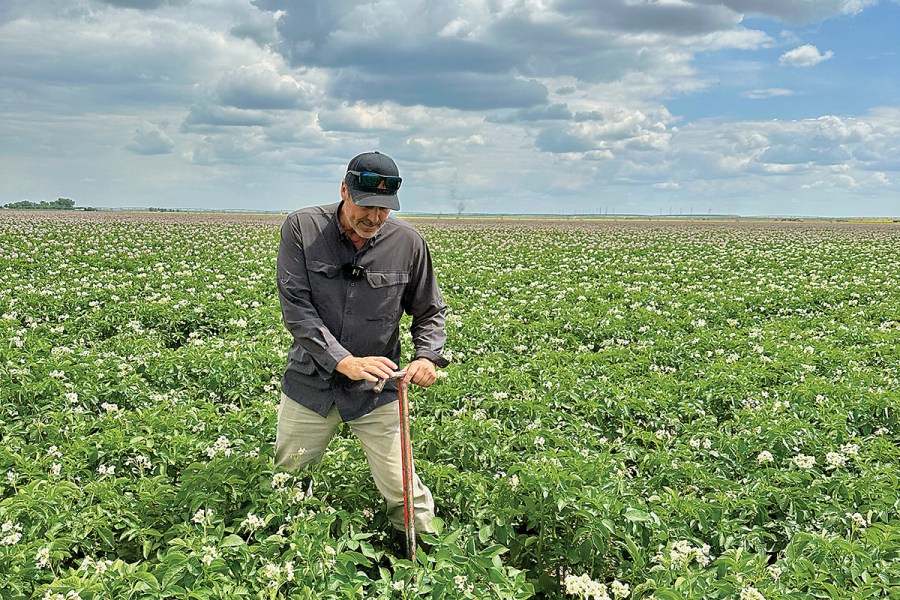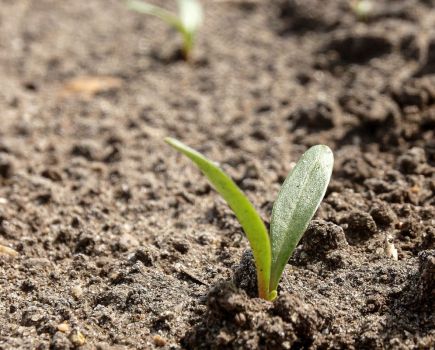A large-scale Canadian potato grower is seeking to minimise the farm’s impact on the environment, while operating within a challenging landscape. CPM went to visit.
“The soil biology is what makes the most of your organic matter and humus in your soil.”
By Mike Abram
The team at Perry Farm are having their weekly agronomy meeting. In-house agronomist Florian Dieker, plus three of brothers Harold and Chris Perry’s daughters, have spent a day digging tuber samples, measuring soil moisture deficits, and taking photos of every potato field across the 1872ha business.
The scouting reports and other information such as NDVI satellite imagery, in-season weekly soil and leaf tissue nutrient analyses, and soil moisture deficit graphs, are available via the cloud to the team which also includes irrigation manager, Steve Ivan. The information is used to assess management requirements for the coming week.
The key crop is potatoes – the business grows for both McCain, which has a facility across the road, and Frito-Lay. Around 25,000t of the 30,000t crop is stored, with the last crops not leaving store until July or August. Other crops in the rotation include durum and winter wheat, faba beans, sugar beet and canola (spring oilseed rape).
Most of the discussion revolves around irrigation. All crops grown on the farm, which is just outside of Coaldale in southern Alberta, Canada, lie under 36 pivot irrigators. Dryland farming in the region is virtually impossible, with the irrigation water sourced from snow or glacier melt from the Rocky Mountains.
As with many places globally, water availability is becoming more challenging in the region. Snow melt concluded three weeks earlier than usual this year and a dry June led to restrictions being instigated for how much water farms could use.
With the 640ha of potato crops at full canopy in late June, the Perrys had used around half of their reduced 350mm/acre allowance from the local Alberta irrigation district.
“I’m a little worried about over-watering,” says Chris. With overall responsibility for storage, he’s concerned that the scouting highlighted some wet spots in fields, which could affect long-term storability.
Harold’s counter argument is the crop draws more water than at any other time during this period as the rows aren’t completely closed. “The sun’s still evaporating some water off, and the plants are both closing the rows and bulking tubers at the same time,” he explains to CPM later.
Even so, a decision is made to cut irrigation to two applications of 0.67in/acre (42mm/ha) on those fields in the next week rather than three, although Harold, who makes final calls on agronomic decisions, will check the fields to confirm.
“I’m more of the dirt guy,” he says. That’s one of the reasons he’s pushed the farm to embrace regenerative agriculture practices as much as it can on a farm where potatoes are the core business.
Backing off on tillage is the toughest challenge for potato growers seeking to follow regenerative farming principles, and while Perry Farms is far from zero tillage, their system now entails much less soil disturbance than many of their neighbours.
Harold explains that potato growers in the region typically use two or even three passes of a deep cultivator, such as a Kuhn Dominator, to move and lift soil to a depth of 10-12in (25-30cm) in the autumn before planting a potato crop. “That’s tonnes of horsepower and diesel, burning carbon into the atmosphere and turning the field black.”
In some cases, ridges are then formed in the autumn and left bare during the winter, leaving them vulnerable to wind erosion before potatoes are planted in the spring. The first step Harold took was to reduce the risk of erosion by mounting a Valmar seeder unit on the Dammer Diker ridger, to plant cover crops into the cultivated soil at the same time as ridging.
But during the past three seasons he’s trialled planting the cover crop and ridging in one-pass directly into the stubble without prior cultivation. A Schmeiser packer is pulled behind the ridger/seeder unit to create better seed-to-soil contact for the cover crop.
Potatoes usually follow a grain crop, such as wheat, with the only post-harvest operations being to spread compost made from locally sourced cattle feedlot manure (see panel) and to ‘shred’ the stubble.
Leaving longer stubbles when harvesting increases output, explains Harold. “We’re working against the clock and the more you put through the combine the slower you must go.”
But the longer stubble causes problems with bunging up the potato planter in the spring, so they use a mower to shred it before planting the cover crop, ideally by the middle of August, as there’s only a short window before first frosts arrive at the beginning of October.
To support germination and maximise cover crop growth in that period he uses irrigation, at least until the canal transportation system is emptied at the beginning of October. Irrigation can also be used to help with the initial cover crop drilling operation if the soil is too hard post-harvest, says Harold.
“We’re no longer working the soil two or three times to turn it brown and the stubble and cover crop helps prevent our land blowing in winter, which seems to be becoming an increasing problem in Alberta.
“We also have some soil armour to stop the sun and rain beating down, creating a better soil structure.”
The cover crop contains species such as winter peas, flax, oats, and other grain species that’ll survive at least into and some through the winter, but not cereal rye, which is becoming a problem to control in winter wheat crops.
“Last season we were lucky that we had until the middle of November for the cover crop to continue growing with no frosts severe enough to kill it.”
Harold explains that ensuring there’s living roots in the soil for as much of the year as possible helps to utilise the sun’s energy, with the plants making sugars and carbohydrates to feed microbes in his soils. “The soil biology is what makes the most of your organic matter and humus in your soil.”
It’s the type of organic matter that lasts longer in your soils, he claims. “Humus made from mycorrhizal fungi, for example, lasts much longer than if straw is digested by a worm.”
He’s also starting to integrate livestock, with a neighbour supplying fences and rotationally grazing cows on some fields, and Harold says it’s hands down the fastest way to build organic matter.
The potatoes are planted after the remaining cover crop and stubble residue has been rototilled in the spring. “It’s like incorporating a green manure,” he says. “If we have too much residue and a wet spring where the straw doesn’t dry up enough to break up and flow through the planter shoes, it’ll cause plugging with our planter.”
In-season, he’s working to reduce inputs in the potato crop. Compost and digestate from an on-site digester plant (see box) have reduced synthetic nitrogen requirements by nearly 50% across the farm, with some fields unlikely to receive any synthetic nitrogen this year.
Regular soil tests help to inform how much synthetic nitrogen and other nutrients have to be applied in the irrigation water. On flat fields, Harold says zoning for variable rate applications hasn’t brought much benefit, but it’s being used on rolling land to improve efficiency.
He’s also trialling Azotic Technologies’s Envita on a couple of fields again this season to see whether it can help to reduce synthetic nitrogen requirements.
Envita is a naturally occurring bacteria, Gluconacetobacter diazotrophicus, which lives in the roots and foliage of plants and fixes atmospheric nitrogen to make it available to the plant. “In test digs last year we saw a yield increase, but not when we harvested the field, so the jury’s out,” comments Harold.
Another aspect he’s experimenting with is treating his irrigation water with a Rainmaker. A fraction of the irrigation water in the main line is diverted into a side line, where air that’s been sucked over ultraviolet lights to create ozone (O3) is dispersed into the water as micro- and nano-bubbles.
Hydrogen peroxide is added as catalyst for the generation of highly reactive hydroxyl radicals, which when the treated water is added back into the main line, helps to remove contaminants such as algae and bacteria, and buffer the irrigation water to a neutral pH.
“A local potato grower had good results so I went a bit crazy and bought 10 of these units, they’ll treat 2300 gallons/minute,” says Harold. “The idea is the water penetrates better through the soil, so you get improved infiltration and soil health. The manufacturers claim we should use 30% less water.”
Harold is working with a local research station to trial the system in various crops including potatoes, faba beans, OSR and durum wheat. “We’re testing the water before and after treatment, comparing carbonate levels, yields and margins.”
With a setup cost of CA$45,000 (£26,400) he’s hoping for a yield increase of around 0.5t/ac (1.25t/ha) in potatoes or 15bu/ac (0.8-1t/ha) in grain crops to produce a return on investment of CA$150/ac (£200/ha).
Fungicide seed treatments are also under the microscope. Ideally Harold would prefer to not use them as he believes they interfere with soil biology by picking up on signals sent by plant roots. While he’s been able to cut it out, or replace it with mono silicic acid in some places, it’s difficult on one potato variety he grows which is susceptible to fusarium. “If I can get by without it though I think I’ll have a stronger plant.”
Other diseases, such as early blight (alternaria), black dot and the storage disease pink rot, are dealt with by using nutrition where possible. “We use phosphite as an elicitor to produce an immune response in the potato plant to help against pink rot. Last year, we didn’t use any fungicides,” he says.
Pests, though, are a bigger agronomic challenge, with Colorado potato beetle requiring an insecticidal seed treatment. “I haven’t figured those guys out yet,” comments Harold.
One strategy that’s being tested is growing wildflower margins by the side of potato crops, and larger areas of unirrigated herbal leys to provide favourable habitats for beneficial insects.
He’s also considering other environmental features in small areas of fields that have drainage issues. “What I want to do is put a pond in with some trees around it, which’ll provide cover for birds and they can eat the grasshoppers and other insects. The birds are scared to come out this far because we have falcons and sparrowhawks, but if I put some cover for them, maybe they will,” he concludes.
Mike Abram visited Perry Farms as part of the International Federation of Agricultural Journalists Congress in Alberta, Canada, part supported by the Joe Watson Legacy Fund.
This article was taken from the latest issue of CPM. Read the article in full here.
For more articles like this, subscribe here.
Sign up for Crop Production Magazine’s FREE e-newsletter here.




